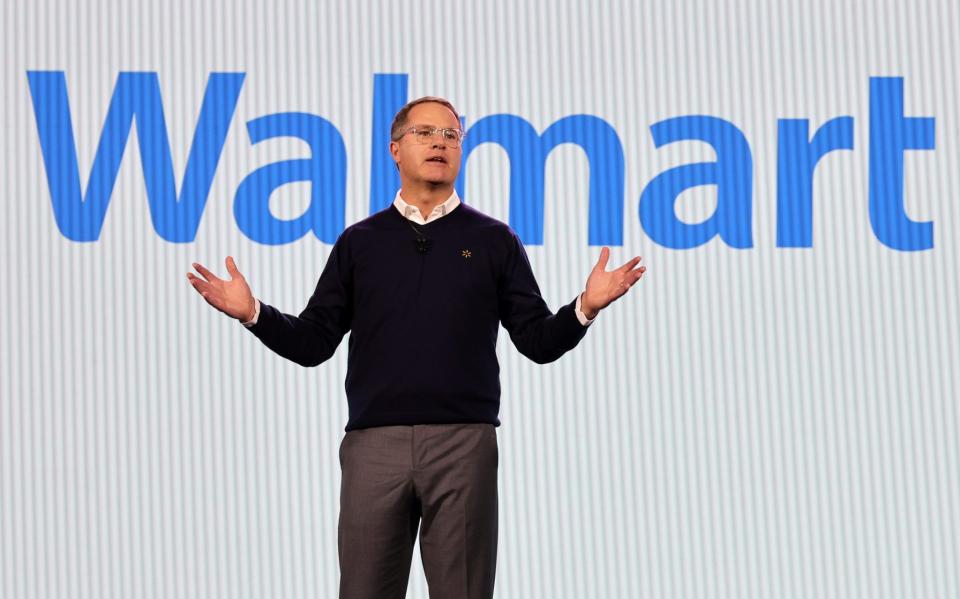Walmart’s $2.3 billion Vizio acquisition is very much about Amazon envy

Walmart plans to acquire TV maker Vizio for $2.3 billion, in a deal that has little to do with the business of selling TVs. That’s perhaps a weird thing to say about the purchase of a TV maker that has long been a top TV seller at Walmart.
But Walmart’s real interest in the electronics company is its operating system and advertising business, and how it will let Walmart give brands more ways to advertise to consumers, and more data about their interests. If you own a Vizio TV, your eyeballs and viewing habits are what Walmart and their biggest advertisers want.
“The combination would be expected to further accelerate Walmart’s media business in the U.S., Walmart Connect, bringing together Vizio’s advertising solutions business with Walmart’s reach and capabilities,” is how Walmart described it in a press release announcing the deal on Tuesday.
Today, Walmart sells ads on its website and app—some that resemble traditional online ads and others in product search results that carry a “sponsored” label—as well as on the screens of TVs in its stores, and on self-checkout kiosks.
Why does Walmart care about building a big ad business? Because it has the potential to be much more profitable than Walmart’s core retail business. And Walmart needs that extra cash to continue to invest in retail capabilities like delivery and automation to compete with, or beat, rivals like Amazon. Yes, in the retail industry, a lot of big moves outside of Amazon are in some way still influenced by Amazon.
Walmart’s ad revenue grew 28% in its 2024 fiscal year, which runs through January, to $3.4 billion. Meanwhile, Amazon’s advertising business grew 24% year over year in the 2023 calendar year, but it’s 13 times as big with nearly $47 billion in revenue. Walmart also wants to become a bigger player in streaming TV advertising specifically, where Amazon has been making bold moves.
Profits from Walmart’s ad business as well as its Sam’s Club and Walmart+ delivery memberships should account for about 20% of the company’s overall operating income during the current fiscal year, an executive said.
“These profit streams allow us to fund investments in our core business,” Walmart CFO John David Rainey said on an earnings call with analysts on Tuesday.
But Amazon also has other profitable businesses that provide extra cash to invest elsewhere. The biggest is Amazon Web Services, which generated $90 billion in revenue in 2023. AWS accounted for two-thirds of Amazon’s overall operating income of nearly $37 billion in 2023.
Walmart, of course, doesn’t have its own cloud computing service to counter AWS. But Walmart CEO Doug McMillon, who became chief executive 10 years ago, has been paying close attention to Amazon’s buildout of these new massive profitable business lines outside of its core e-commerce operation. And as a result, he’s urged his leaders to develop new revenue streams for Walmart. Internally, McMillon has talked about these new ideas as ways of “making money while we sleep,” a company insider told me for my recent book, Winner Sells All, about the Amazon-Walmart rivalry.
The ad business, called Walmart Connect, is one. Walmart has also created a data business called Walmart Luminate that scoops up information about Walmart customer shopping habits and sells access to the retailer’s suppliers. Walmart has also introduced same-day delivery service for third-party retailers, Walmart GoLocal. The Walmart membership program Walmart+, which launched three years ago, is another attempt by the legacy retailer to generate more cash to invest in keeping prices low, and adding new services to make shopping more convenient for Walmart customers.
Then there’s Walmart Health, a chain of medical clinics that the retailer has been building to serve as sort of supercenters for medical care. A former Walmart Health leader, Marcus Osborne, told me in my book, Winner Sells All, that McMillon was interested in building a large health division at least partly because of the cash flow it could provide to help Walmart defend against Amazon’s encroachment on the crucial grocery segment of its business.
“I’m not naturally a risk taker,” McMillon said in the book. “I don’t gamble. I don’t jump off bridges with a bungee cord.”
“But this company,” he added, “to be here in the next generation, has to take risks.”
Walmart’s acquisition of Vizio is just the latest one.
Do you have thoughts on this topic or a tip to share? Contact Jason Del Rey at jason.delrey@fortune.com, jasondelrey@protonmail.com, or through secure messaging app Signal at 917-655-4267. You can also message him on LinkedIn or at @delrey on X.
This story was originally featured on Fortune.com

 Yahoo Finance
Yahoo Finance 